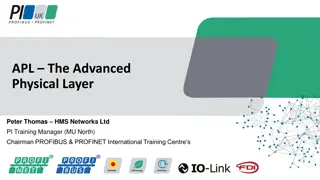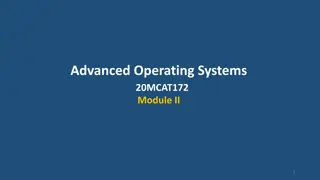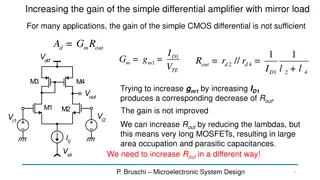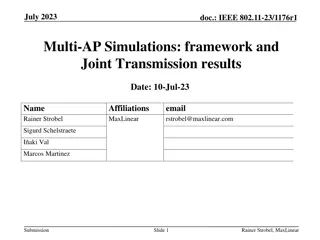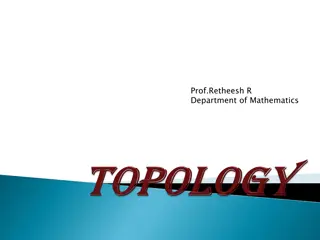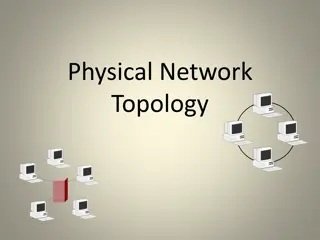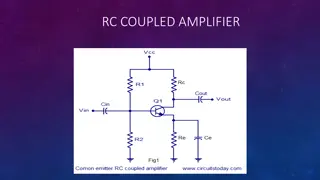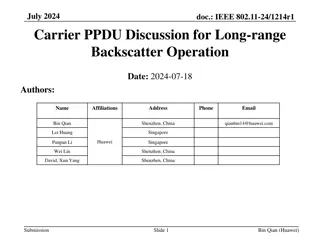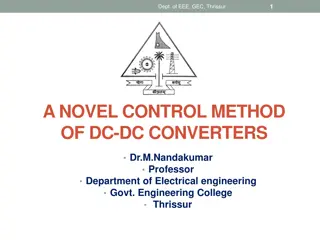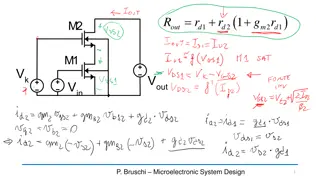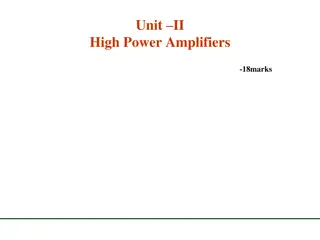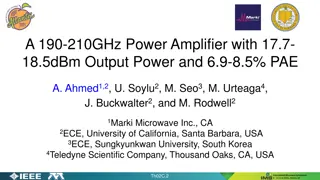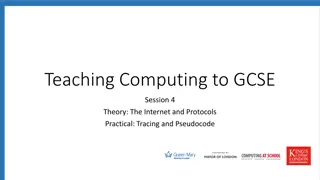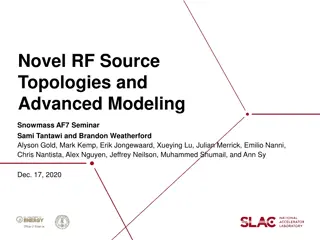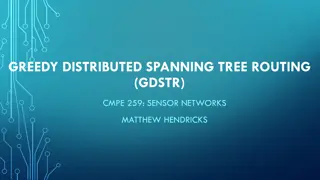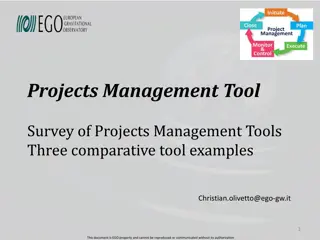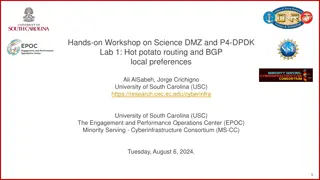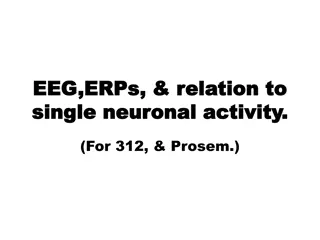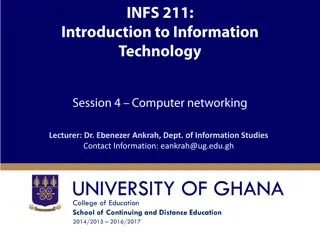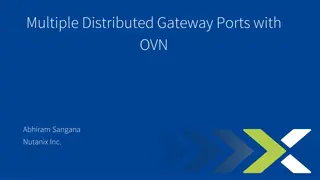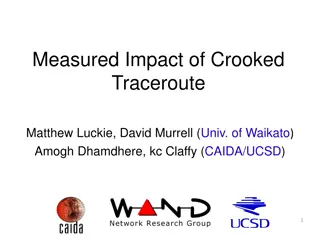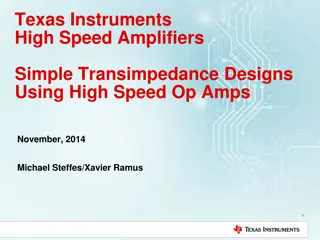Year 8 AP2 Knowledge Organiser - March 2024
This knowledge organiser covers various topics such as data transmission via a network, LAN networks, algorithms, domain names, URL's, computer connections, values comparison, network topologies, WAN concepts, binary conversion, image resolution, sound waves, VOIP, internet vs. WWW differences, data
1 views • 4 slides
Understanding Network Topologies: Bus vs Ring
Explore the world of network topologies with a focus on Bus and Ring configurations. Learn about their features, advantages, and disadvantages, helping you understand the layout and connectivity options in computer networks.
6 views • 80 slides
Understanding Computer Networks: Basics, Components, and Topologies
Computer networks are essential for sharing resources, exchanging files, and enabling electronic communications. This includes components like senders, receivers, messages, transmission media, and various modes of communication. The need for networking arises from file sharing, resource sharing, com
14 views • 28 slides
APL - The Advanced Physical Layer in Industrial Networks
APL, the Advanced Physical Layer, is transforming the process industry by offering an Ethernet-based alternative to traditional fieldbus methods like PROFIBUS PA. Through APL, enhanced connectivity, efficiency, and flexibility are achieved. The technology involves topologies, cabling specifications,
7 views • 29 slides
Coverage Semantics for Dependent Pattern Matching
Delve into the world of dependent pattern matching with a focus on coverage semantics. Dive deep into the concepts of denotational semantics, topologies, and coverages. Explore the interplay between patterns, values, and types in a novel way, shedding light on the essence of pattern matching.
4 views • 26 slides
Advanced FPGA Design: Ensuring Safety, Reliability, and Predictability
With a background in MSc Applied Physics and 10 years of experience in FPGA development, the focus is on verifying asynchronous and analog aspects of FPGA design for safe, reliable, and robust performance. Limited resources and articles drive the need to collaborate for knowledge sharing and explori
0 views • 18 slides
Understanding Distributed Mutual Exclusion in Operating Systems
In distributed systems, the problem of mutual exclusion arises when multiple sites/processes need to access shared resources concurrently. Unlike in single-computer systems, distributed systems lack shared memory, leading to the need for communication-based approaches rather than shared variables li
0 views • 49 slides
Understanding Mesh and Star Network Topologies
Network topology plays a crucial role in network performance and maintenance costs. Mesh topology connects every device with a dedicated link, providing reliability and security. On the other hand, star topology connects devices to a central hub, ensuring communication through the hub. Explore the a
0 views • 22 slides
Techniques to Increase Gain in a Simple Differential Amplifier
Explore methods to boost the gain of a simple CMOS differential amplifier by replacing the current mirror with a cascode mirror, adding a common-gate stage, and employing a cascode differential amplifier. These techniques help improve Rout without extensive use of long MOSFETs, optimizing the amplif
2 views • 30 slides
IEEE 802.11-23/1176r1 Multi-AP Simulations Overview
Detailed exploration of Joint Transmission (JT) simulation results for IEEE 802.11-23/1176r1, emphasizing real-world deployment scenarios in residential settings. The submission discusses topologies, considerations, and initial simulation outcomes, aiming to align with the UHR project goals and opti
0 views • 24 slides
Introduction to Topological Spaces and Examples
Topology is the study of surfaces derived from Greek words meaning surface and discourse. In mathematics, a topological space is a set with a family of subsets satisfying specific properties. Examples include the open ball, open set, indiscrete topology, discrete topology, co-finite topology, and co
0 views • 14 slides
Understanding Feedback Amplifiers: Structure, Properties, and Topologies
Electronic circuits rely heavily on feedback mechanisms, particularly negative feedback, for various purposes such as desensitizing gain, reducing distortion, controlling impedance, and improving amplifier bandwidth. This article explores the general structure of feedback, properties of negative fee
0 views • 68 slides
Understanding Physical Network Topologies
Physical network topology refers to the layout of cables, computers, and peripherals in a network, distinct from logical topology. Common physical topologies include Star, Ring, Linear Bus, Tree, and Mesh. Each topology has its advantages and disadvantages, impacting network performance and reliabil
0 views • 16 slides
Understanding VSAT Technology and Applications
Very Small Aperture Terminal (VSAT) technology revolutionized satellite communications by enabling smaller, more cost-effective earth stations. This article covers the basics of VSAT, its components, advantages, disadvantages, network topologies, and a practical example of its application in KSA. It
2 views • 21 slides
Understanding Practical Op-Amp Circuits: Inverting, Noninverting, and More
Explore practical op-amp circuits such as inverting amplifier, noninverting amplifier, unity follower, summing amplifier, and integrator. Learn how to calculate output voltages for various configurations and understand their applications with examples.
0 views • 17 slides
Understanding RC Coupled Amplifiers and Transistor Basics
Amplification is the process of increasing signal strength without changing its characteristics. An RC coupled amplifier is a multistage amplifier using resistors and capacitors. Transistor amplifiers amplify signals based on transistors with different configurations. The common emitter configuratio
0 views • 23 slides
Carrier PPDU Discussion for Long-range Backscatter Operation in IEEE 802.11-24
This document discusses the use of Carrier PPDU for long-range backscatter operation in IEEE 802.11-24 standard. It covers topics such as close-range and long-range backscatter in AMP, reader PPDU for close-range operation, and different topologies to support long-range backscatter. The content incl
0 views • 14 slides
Transimpedance Amplifiers in CMOS Technology for Optical Communications at 40 Gb/s
This research by Joseph Chong at Virginia Tech delves into the use of transimpedance amplifiers (TIAs) in CMOS technology for optical communications operating at a data rate of 40 Gb/s. The study outlines the motivation behind the project, the role of TIAs in optical receivers, TIA circuit topologie
0 views • 52 slides
Novel Control Methods of DC-DC Converters in Electrical Engineering
Introduction to a novel control method of DC-DC converters in electrical engineering focusing on various converter topologies, closed-loop control techniques, performance comparison of controllers, and drawbacks with modifications. The presentation covers essential aspects such as regulation, conver
0 views • 51 slides
Understanding Token Ring Technology in Computer Networks
Token Ring, developed by IBM, is a networking technology that uses a token passing scheme for data transmission. Devices on the network take turns transmitting data by holding a token and releasing it after data transfer. Unlike Ethernet, Token Ring offers unique benefits and operates efficiently in
2 views • 17 slides
Microelectronic System Design by P. Bruschi - Overview of Cascode Current Mirrors and Wide Swing Configurations
Explore the detailed design of microelectronic systems by P. Bruschi, focusing on cascode current mirrors and wide swing configurations. The content includes various images illustrating classic and non-optimal topologies, parameters, and voltage shifters for MOSFET mirrors. Learn about high precisio
0 views • 14 slides
Understanding High Power Amplifiers with BJT for Efficient Performance
Explore the world of high-power amplifiers utilizing BJT technology, focusing on factors like linearity, efficiency, and maximum power capability. Learn about different amplifier classes - A, B, AB, and C - each with unique operating characteristics. Discover the significance of amplifier efficiency
0 views • 22 slides
High-Efficiency Power Amplifier Design for 190-210GHz Range
Optimizing for high efficiency at OP1dB, this work presents a power amplifier operating in the 190-210GHz range with an output power of 17.7-18.5dBm and PAE of 6.9-8.5%. Utilizing a 250nm InP HBT process, the amplifier integrates four stages and demonstrates a gain of approximately 23dB. Key design
0 views • 26 slides
Comprehensive Overview of Computer Networks and Protocols for GCSE Level
Explore the diverse aspects of computer networks and protocols through in-depth discussions on LAN, WAN, client-server relationships, hardware requirements, network topologies, protocols like TCP/IP and HTTP, and the significance of network layers. Understand the roles, benefits, and risks associate
0 views • 23 slides
Innovations in RF Source Topologies and Modeling for Enhanced Efficiency
Explore novel RF source topologies and advanced modeling techniques to achieve higher efficiency and power density in RF systems. Discover tradeoffs, multi-beam arrays, radial beam klystrons, and deflected beam amplifiers for improved performance in high-power applications.
0 views • 15 slides
Understanding Greedy Distributed Spanning Tree Routing in Wireless Sensor Networks
Wireless sensor networks play a critical role in various applications, and the Greedy Distributed Spanning Tree Routing (GDSTR) protocol, developed by Matthew Hendricks, offers an efficient routing approach. This protocol addresses challenges such as scalability, dynamic topologies, and sensor node
0 views • 34 slides
Comprehensive Review of BJT CE Voltage Amplifier in Electronics Lab
This lecture provides a comprehensive review of the BJT CE voltage amplifier circuit, starting with theoretical concepts and moving towards practical implementations. It covers the operation of the BJT as a switch, the addition of resistors for current control, DC design considerations, AC voltage g
0 views • 19 slides
Projects Management Tools Overview and Comparison
Explore the evolution of project management tools from the early 20th century to modern times. Learn about key figures like Frederick Taylor and Henry Gantt, and discover the variety of project management software available today. Delve into requirements for choosing the right tool and understand di
0 views • 28 slides
Exploring Philosophical Implications of General Relativity: Black Holes, Cosmology, and More
Delve into the profound implications of General Relativity on topics such as black holes, cosmology, and philosophical consequences from Special and General Relativity. Discover how curved geometry allows for different topologies, potential return of preferred frames, the concept of horizons near bl
0 views • 18 slides
Enhancements for Off-Channel Peer-to-peer Communications in IEEE 802.11-24/393r3
This contribution discusses enhancements for Off-Channel Peer-to-peer (P2P) communications in IEEE 802.11-24/393r3, building upon prior work in this area. It explores the concept of recommended P2P channels and how APs can incentivize P2P STAs to use these channels for better communication quality.
0 views • 12 slides
Hands-On Workshop on Science DMZ and P4-DPDK Lab
Join the workshop at the University of South Carolina to learn about hot potato routing, BGP local preferences, and hands-on lab activities focusing on network topologies and configurations. Explore the Lab Topology, Lab Configuration, and Platform Information for an interactive learning experience
0 views • 6 slides
Understanding Local Area Networks: Basics, Advantages, and Disadvantages
A Local Area Network (LAN) serves various functions such as file serving, print serving, video transfers, and more. LANs offer advantages like resource sharing, private ownership, and secure transfers, but come with disadvantages such as costliness and maintenance issues. Different LAN topologies li
1 views • 50 slides
Understanding the Relationship between EEG, ERPs, and Single Neuronal Activity
This detailed information discusses the relationship between EEG, ERPs, and single neuronal activity, exploring how electrodes record signals based on tip diameter and biological amplifier filter settings. It delves into parameters that determine what an electrode records, highlighting the importanc
0 views • 56 slides
Octavia Project Overview and Updates
Octavia is a network load balancing service in OpenStack that provides scalable, on-demand, and self-service access to load balancer services. The project has evolved to encompass all network load balancing and offers key features such as flexible network topologies, highly available load balancers,
0 views • 11 slides
Understanding Computer Networks in Education: A Session Overview
Explore the world of computer networks with Dr. Ebenezer Ankrah from the Dept. of Information Studies. Discover network categories, types, topologies, bandwidth, and more. Gain insights on server-based vs. peer-to-peer networks and key network concepts. Dive into essential topics covered in the sess
0 views • 33 slides
Advanced Networking with Multiple Distributed Gateway Ports in OVN
Explores the latest advancements in networking technology with OVN by allowing the creation of multiple Distributed Gateway Ports per logical router. This feature enables connectivity to multiple external networks, supporting scenarios like shared services, NAT configurations, and load balancing. Di
0 views • 7 slides
Understanding the Impact of Crooked Traceroute on Network Topologies
Traceroute-based algorithms play a crucial role in collecting network topology data, but the introduction of per-flow load balancing has raised concerns about the accuracy of these algorithms. This study examines the implications of crooked traceroute on false link inference rates and the identifica
0 views • 23 slides
High-Speed Amplifiers: Design Techniques and Considerations
This detailed document explores the design aspects of high-speed amplifiers, focusing on transimpedance designs using high-speed op-amps. It covers basic and advanced design issues, frequency response analysis, and key considerations for achieving desired performance. The content emphasizes simplifi
0 views • 44 slides
Shipboard Network Principles and Topologies
Explore the fundamentals of shipboard networking including wired and wireless topologies, networked devices onboard, and typical configurations for IT systems and crew WiFi. Learn about various network structures, their benefits, drawbacks, and potential applications within a maritime setting.
0 views • 11 slides
FX-Audio DAC X6 Overview and Teardown Analysis
FX-Audio DAC X6 is a digital-to-analog converter with a built-in amplifier designed for higher impedance headphones like the Drop K7XX. The device features multiple inputs including Optical, USB, and Digital Coax, with outputs to line-out RCA ports and headphones. A breakdown of the internal compone
0 views • 4 slides



